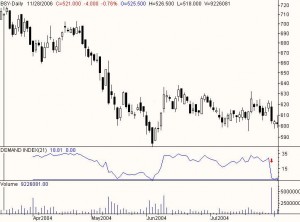Mr. Sibbet defined six “rules” for the Demand Index:
1. A divergence between the Demand Index and prices suggests an approaching weakness in price.
2. Prices often rally to new highs following an extreme peak in the Demand Index (the Index is performing as a leading indicator).
3. Higher prices with a lower Demand Index peak usually coincides with an important top (the Index is performing as a coincidental indicator).
4. The Demand Index penetrating the level of zero indicates a change in trend (the Index is performing as a lagging indicator).
5. When the Demand Index stays near the level of zero for any length of time, it usually indicates a weak price movement that will not last long.
6. A large long-term divergence between prices and the Demand Index indicates a major top or bottom.
Calculation
The Demand Index calculations are too complex for this book (they require 21-columns of data).
Sibbet’s original Index plotted the indicator on a scale labeled +0 at the top, 1 in the middle, and -0 at the bottom. Most computer software makes a minor modification to the indicator so it can be scaled on a normal scale.
